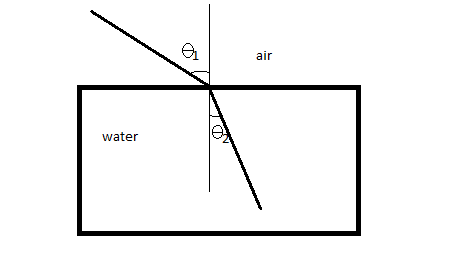
Define refraction and state laws of refraction.
Answer
516.6k+ views
Hint: when a light incident from one medium to the other changes its direction then this phenomenon is known as refraction of light. There are two laws of refraction that are used to describe the behavior of light after refraction.
Complete step by step answer:
A refraction is a phenomenon in which light changes its direction when it is subjected to one medium into the other. This change in the direction will be the cause of the difference in densities in two substances.
The figure below shows the refraction of light from air to water.

Here, you can see when a light travelling in the air is incident on the water it changes its angle from $${\theta _1}$$ to ${\theta _2}$ . Here, ${\theta _1}$ represents the angle of incidence and ${\theta _2}$ represents the angle of refraction.
LAWS OF REFRACTION:
There are two laws of refraction which are given below:
The first law of refraction: the first law of refraction states that the incident ray, the refracted ray, and the normal, to the interface of the two mediums at the incidence point, lie in the same plane.
The second law of refraction: the second law of refraction states that the ratio of the sine of the angle of incidence and the sine of the angle of refraction is constant. This law is also known as Snell’s law and is given by
$\dfrac{{\sin \,i}}{{\sin \,r}} = \,\mu $
Here, $i$ is the angle of incidence, $r$ is the angle of refraction and $\mu $ is the constant which is also known as the refractive index of the medium.
Note:
If the light enters a medium having a high refractive index, it will slow down and it will bend towards the normal.
If the light enters a medium having a low refractive index, it will speed up and it will bend away from the normal.
The second law of refraction states that the ratio of the sine of the angle of incidence and the sine of the angle of refraction is constant.
Complete step by step answer:
A refraction is a phenomenon in which light changes its direction when it is subjected to one medium into the other. This change in the direction will be the cause of the difference in densities in two substances.
The figure below shows the refraction of light from air to water.

Here, you can see when a light travelling in the air is incident on the water it changes its angle from $${\theta _1}$$ to ${\theta _2}$ . Here, ${\theta _1}$ represents the angle of incidence and ${\theta _2}$ represents the angle of refraction.
LAWS OF REFRACTION:
There are two laws of refraction which are given below:
The first law of refraction: the first law of refraction states that the incident ray, the refracted ray, and the normal, to the interface of the two mediums at the incidence point, lie in the same plane.
The second law of refraction: the second law of refraction states that the ratio of the sine of the angle of incidence and the sine of the angle of refraction is constant. This law is also known as Snell’s law and is given by
$\dfrac{{\sin \,i}}{{\sin \,r}} = \,\mu $
Here, $i$ is the angle of incidence, $r$ is the angle of refraction and $\mu $ is the constant which is also known as the refractive index of the medium.
Note:
If the light enters a medium having a high refractive index, it will slow down and it will bend towards the normal.
If the light enters a medium having a low refractive index, it will speed up and it will bend away from the normal.
The second law of refraction states that the ratio of the sine of the angle of incidence and the sine of the angle of refraction is constant.
Recently Updated Pages
Master Class 12 Business Studies: Engaging Questions & Answers for Success

Master Class 12 Biology: Engaging Questions & Answers for Success

Master Class 12 Physics: Engaging Questions & Answers for Success

Class 12 Question and Answer - Your Ultimate Solutions Guide

Master Class 12 English: Engaging Questions & Answers for Success

Master Class 12 Economics: Engaging Questions & Answers for Success

Trending doubts
Which are the Top 10 Largest Countries of the World?

What is transplantation in agriculture class 12 biology CBSE

Differentiate between homogeneous and heterogeneous class 12 chemistry CBSE

Why is the cell called the structural and functional class 12 biology CBSE

Hydrological cycle is controlled by A Grasslands B class 12 biology CBSE

Who discovered the cell and how class 12 biology CBSE




